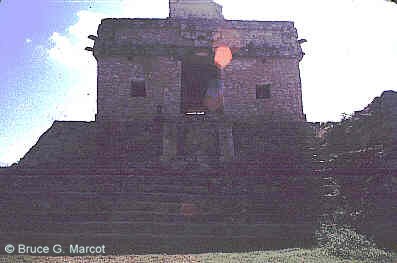

It has been hypothesized that the Temple was an astronomical observation center, as sighting lines have been discovered within the structure that align with constellations and planets at key dates. The door jamb and windows can be used to line up with pillars that likely adorned courtyard enclosures not shown here. Note the squarish structure in the top center of the entrance stairs, above; this is a pit dug into the stairwell that once held sighting-line pillars that aided astronomical observations made from within the building.
But the main point here is how the very design of this Temple matches other Mayan designs -- such as the Mayan house carved into the side of the Nunnary Quadrangle in nearby Uxmal, and the rear head of the two-headed monster from faraway Palenque.
Even more striking is that, carved onto each side and each corner of the Temple of the Seven Dolls is a stone face that conjures the rear head of the two-headed monster, and which mimics the entire design of the Temple itself -- another example of recursion and iteration in Mayan architectural design and symbolism. (The faces are barely visible in the above photo, in the top center above the main entrance and on the two roof cornices.) Thus, sites such as this Temple were important intersections of symbolism for astronomical and religious purposes alike.
Science -- astronomy and mathematics -- begat the ability to recount, and then predict, seasonal changes as well as natural calamities -- including the tilt of seasons and the startling events of lunar and solar eclipses. Recording events by glyphs on stelae (stone columns), on building facades, on frescoes, and in book "codices," allowed the Mayans to also record major political events such as the founding or razing of cities and tribes. To the Mayans, language, ritual, symbolism, science, and agriculture were but different facets of a larger whole of life -- one that we only superficially, and perhaps could never fully, comprehend.
Back to the Ancient America Page
Back to The Knowledge Plexus